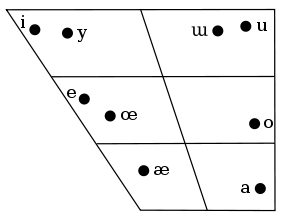Karakalpak language
| Karakalpak | |
|---|---|
| Qaraqalpaq tili, Қарақалпақ тили | |
| Native to | Uzbekistan, Kazakhstan, Afghanistan, Russia |
| Region | Karakalpakstan |
Native speakers | 410,000 (1993)[1] |
| Official status | |
Official language in | Karakalpakstan (Uzbekistan) |
| Language codes | |
| ISO 639-2 |
kaa |
| ISO 639-3 |
kaa |
| Glottolog |
kara1467[2] |
|
Map showing locations of Karakalpak (red) within Uzbekistan | |
Karakalpak is a Turkic language mainly spoken by Karakalpaks in Karakalpakstan (Uzbekistan), as well as by Bashkirs and Nogay. Ethnic Karakalpaks who live in the viloyatlar of Uzbekistan tend to speak local Uzbek dialects.
Classification
Karakalpak is a member of the Kypchak branch of Turkic languages, which includes Tatar, Kumyk, Nogai, and Kazakh. Due to its proximity to Uzbek, much of Karakalpak's vocabulary and grammar has been influenced by Uzbek. Like Turkish, Karakalpak has vowel harmony, is agglutinative and has no grammatical gender. Word order is usually subject–object–verb.
Geographic distribution
Karakalpak is spoken mainly in the Karakalpakstan Autonomous Republic of Uzbekistan. Approximately 2,000 people in Afghanistan and smaller diaspora in parts of Russia, Kazakhstan, Turkey, and other parts of the world speak Karakalpak.
Official status
Karakalpak has official status in the Karakalpakstan Autonomous Republic.
Dialects
The Ethnologue identifies two dialects of Karakalpak: Northeastern and Southwestern. Menges mentions a third possible dialect spoken in the Fergana Valley. The Southwestern dialect has č for the Northeastern š.
Sounds
Karakalpak has 21 native consonant phonemes and regularly uses four non-native phonemes in loan words. Non-native sounds are shown in parentheses.

| Labial | Alveolar | Palatal | Velar | Uvular | Glottal | |||||||
|---|---|---|---|---|---|---|---|---|---|---|---|---|
| Nasal | m | n | ŋ | |||||||||
| Plosive | p | b | t | d | k | ɡ | q | |||||
| Affricate | (t͡s) | (t͡ʃ) | ||||||||||
| Fricative | (f) | (v) | s | z | ʃ | ʒ | x | ɣ | h | |||
| Rhotic | r | |||||||||||
| Approximant | l | j | w | |||||||||
Vowel harmony
Vowel harmony functions in Karakalpak much as it does in other Turkic languages. Words borrowed from Russian or other languages may not observe rules of vowel harmony, but the following rules usually apply:
| Vowel | May be followed by: |
|---|---|
| ɡ | a, ɯ |
| æ | e, i |
| e | e, i |
| i | e, i |
| o | a, o, u, ɯ |
| œ | e, i, œ, y |
| u | a, o, u |
| y | e, œ, y |
| o | a, ɯ |
Vocabulary
Personal pronouns
men I, sen you (singular), ol he, she, it, that, biz we, siz you (plural), olar they
Numbers
bir 1, eki 2, uʻsh 3, toʻrt 4, bes 5, altiʻ 6, jeti 7, segiz 8, togʻiʻs 9, on 10, juʻz 100, miʻnʻ 1000
Writing system

Karakalpak was written in the Arabic and Persian script until 1928, in the Latin script (with additional characters) from 1928 to 1940, after which Cyrillic was introduced. Following Uzbekistan's independence in 1991, the decision was made to drop Cyrillic and revert to the Latin alphabet. Whilst the use of Latin script is now widespread in Tashkent, its introduction into Karakalpakstan remains gradual. The Cyrillic and Latin alphabets are shown below with their equivalent representations in the IPA. Cyrillic letters with no representation in the Latin alphabet are marked with asterisks.
| Cyrillic | Latin | IPA | Cyrillic | Latin | IPA | Cyrillic | Latin | IPA | ||
|---|---|---|---|---|---|---|---|---|---|---|
| Аа | Aa | /a/ | Ққ | /q/ | Фф | Ff | /f/ | |||
| Әә | Aʻaʻ | /æ/ | Лл | Ll | /l/ | Хх | Xx | /x/ | ||
| Бб | Bb | /b/ | Мм | Mm | /m/ | Ҳҳ | Hh | /h/ | ||
| Вв | Vv | /v/ | Нн | Nn | /n/ | Цц | Cc | /ts/ | ||
| Гг | Gg | /a/ | Ңң | Nʻnʻ | /ŋ/ | Чч | CHch | /tʃ/ | ||
| Ғғ | Gʻgʻ | /ɣ/ | Оо | Oo | /o/ | Шш | SHsh | /ʃ/ | ||
| Дд | Dd | /d/ | Өө | Oʻoʻ | /œ/ | Щщ* | sh | /ʃ/ | ||
| Ее | Ee | /e/ | Пп | Pp | /p/ | Ъъ* | ||||
| Ёё* | yo | /jo/ | Рр | Rr | /r/ | Ыы | Iʻiʻ | /o/ | ||
| Жж | Jj | /ʒ/ | Сс | Ss | /s/ | Ьь* | ||||
| Зз | Zz | /z/ | Тт | Tt | /t/ | Ээ | Ee | /e/ | ||
| Ии | Ii | /i/ | Уу | Uu | /u/ | Юю* | yu | /ju/ | ||
| Йй | Yy | /j/ | Үү | Uʻuʻ | /y/ | Яя | ya | /ja/ | ||
| Кк | Kk | /k/ | Ўў | Ww | /w/ |
Before 2009, C was written as TS; I and Iʻ were written as dotted and dotless I.
Users
See also
References
- ↑ Karakalpak at Ethnologue (18th ed., 2015)
- 1 2 Nordhoff, Sebastian; Hammarström, Harald; Forkel, Robert; Haspelmath, Martin, eds. (2013). "Kara-Kalpak". Glottolog. Leipzig: Max Planck Institute for Evolutionary Anthropology.
- Menges, Karl H. (1947). Qaraqałpaq Grammar. Translated from German by Leora P. Cunningham. New York: King's Crown Press. OCLC 3615928.
- Johanson, Lars and Csató, Éva Ágnes, eds. (1998). The Turkic Languages. London: Routledge. ISBN 9780415082006. OCLC 40980286.
External links
| Kara-Kalpak edition of Wikipedia, the free encyclopedia |
| ||||||||||||||||||
| ||||||||||||||||||||||||||||||||||||||||||||||||